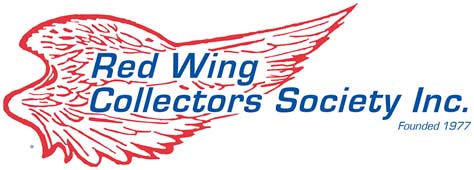There may be a RWCS Chapter near you
Learn more on our Chapters Page.
Membership is only $35 a year and includes six full-color newsletters and exclusive, members only, online content
Question:
I have a set of Red Wing dinnerware in the Rose pattern (square ivory plates with a large mauve rose in the center). It includes place settings for eight (dinner and lunch plates, cups and saucers), and I also have a number of matching serving pieces: coffee server, creamer and sugar bowl, serving platter, serving bowl, relish dish, gravy bowl and covered butter dish. I’d like to sell them but am not sure how to go about it. (Of course, I’d like to get the best price I\’m able to find.) Any assistance you could give me would be appreciated!! We’ll be in Red Wing this coming Sat., the 24th, and I could bring the set along, if that would be helpful. Thank you so much!!! Candy
Answer: From your description (square plates with a single large rose) the name of your pattern is Lexington. It is one of many patterns made in the Concord shape. Lexington was introduced in 1941 and discontinued in 1955. Some of the items you mention (coffee server, relish, butter dish) were not made when this pattern was initially introduced; they were added in the early 1950s as the Concord line expanded. Thus these pieces are not as common as those made throughout the entire life of the pattern.
Approximate values for your items:
Dinner plate: $10-15
Salad or bread plate: $5-10
Cup & saucer: $15
Beverage server with cover: $75-125
Creamer: $10-15
Sugar with cover: $10-15
Platter 13": $20-25
Nappy (open serving bowl): $20-25
Relish dish: $25-30
Gravy boat: $15-20
Butter dish with cover: $30-50
All values assume excellent condition. Chips, cracks, hairlines, stains, and other damage reduce values significantly.
This website offers free information about your Red Wing items, but we do not purchase items or direct you to individuals or business who may be interested.
There are many antique dealers in the Red Wing area and most of them deal in Red Wing pottery and stoneware. Below is some general information you may want to consider when selling your Red Wing.
There are several important factors to consider when selling a collection of Red Wing dinnerware:
1) Speed of sale
2) Time and effort on your part
3) Price expectations
4) Your location (reaching potential buyers)
Here are several ways a person can sell items, along with pros and cons of that method.
Regardless of your location, this is the best way to reach the most potential buyers. Speed of sale and a good price are favorable. But listing items yourself requires significant effort on your part as you must take photos, create the listing (accuracy is imperative), set up billing, pack and ship the item, and deal with any potential problems with the transaction (breakage, non-paying bidders, etc). Cost of shipping can be an issue with large items or numerous pieces.
You bring your items to a business that specializes in listing items on eBay. They handle the "time and effort" issues for you but take a cut from the sales price. Results in less work but also less money for the seller.
Location is important here. This is a viable option if you live in an area where Red Wing is widely collected (upper Midwest) but perhaps not so viable in other areas of the country. Selling to a dealer is quick and doesn’t require much effort, but you won’t realize full price because the dealer needs to make a profit on reselling the items.
Here you retain ownership of the item until it sells. Location is important because you need a shop that will attract Red Wing collectors. Being in an "touristy" area or an area with numerous antique shops helps. Effort required is low, and usually you can set your own price. Speed of transaction can be slow and the shop owner will take a cut from the sales price.
Again, location is a major factor. If you live in an area with a lot of Red Wing collectors, a well-publicized auction will likely draw potential buyers. A few Red Wing pieces in a local general interest auction won’t get much attention. A consignment auction featuring antiques is a better bet; these are usually well-publicized to local collectors. Auctions result in a quick sale with minimal effort, but reaching potential buyers is a concern and you have little control over the selling price. And the auctioneer will take a cut of the sales price.
For the most part these take place only in Minnesota and surrounding states. Members of the Red Wing Collectors Society receive information about some of these auctions through the club newsletter; others can be found via antique publications and websites. Price realized will likely be higher than most venues. The auctioneer will take a cut of the sales price, and it may require some effort to connect with an auctioneer. Depending on the calendar, it may be a while before your item is scheduled to sell. But these auctions are usually well-publicized and should get your item before a good-sized and interested audience. Transportation of your item to the auction location is a consideration.
In years past an ad in an antique publication was the best way to reach potential buyers, but with the widespread use of computers today print ads don’t pack the same punch. Worth considering but probably not the best option for most sellers.
